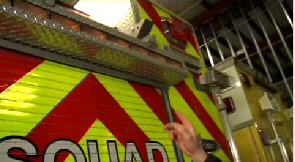In August a report titled “Emergency Vehicle Visibility and Conspicuity Study” was released by the United States Fire Administration in partnership with the International Fire Service Training Association. Here is an excerpt from a summary by Firehouse.
The report from the feds suggests that a lot more could be done to improve passive vehicle visibility and conspicuity. Best practices in emergency vehicle visibility, including cutting edge international efforts, are detailed in the study. Retroreflective striping, chevrons, high-visibility paint, built-in passive lighting and other reflectors for law enforcement patrol vehicles, fire apparatus, ambulances, EMS vehicles and motorcycles are all covered in the report.
Active warning systems, like lights and sirens, are part of a separate federal study and are not included in the August USFA report.
Tutterow is hoping the report catches news media attention and it gains some much needed publicity. He’s also hoping it lasts more than one news cycle.
“Drivers today have too many distractions,” Tutterow said. “They have cell phones, they’re texting, they’re using GPS navigation systems, and they’re using sound systems. They are paying attention to everything but what is in front of them.”
That’s why Tutterow subscribes to a sort of “in-your-face” approach when it comes to retroreflective material and visibility aids.
“I’m not sure that there is such a thing as overkill when it comes to retroreflective material,” he said.
The yellow and red chevron stripping on the backs of apparatus is an example of how something relatively simple and cost effective can have a dramatic affect on responder safety. New apparatus, to be National Fire Protection Association compliant, must have at least 50 percent of the rear body covered with chevron stripping. Tutterow’s hoping emergency responders will see the value and retrofit existing response vehicles to the standard.
Thanks Dick

